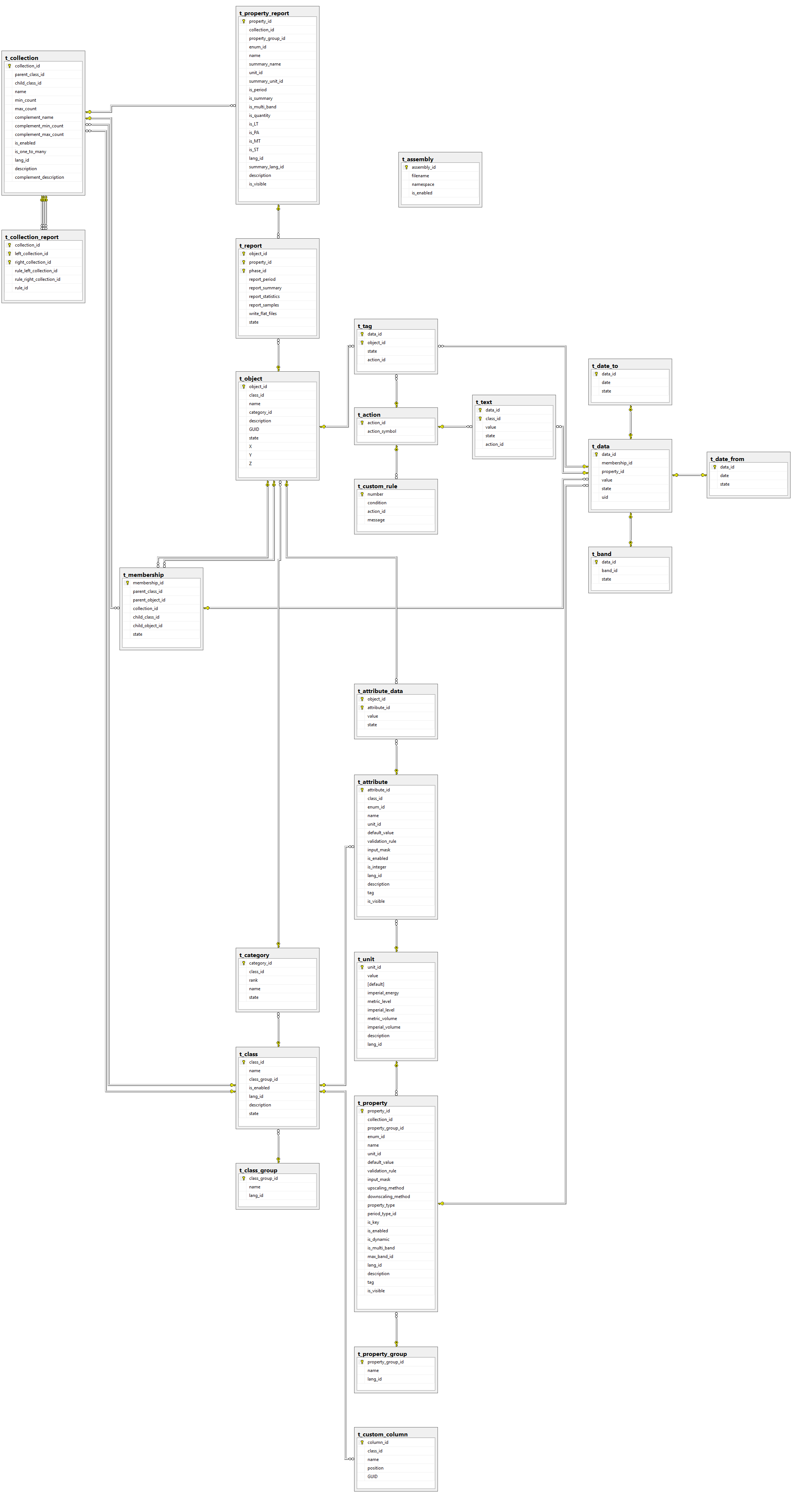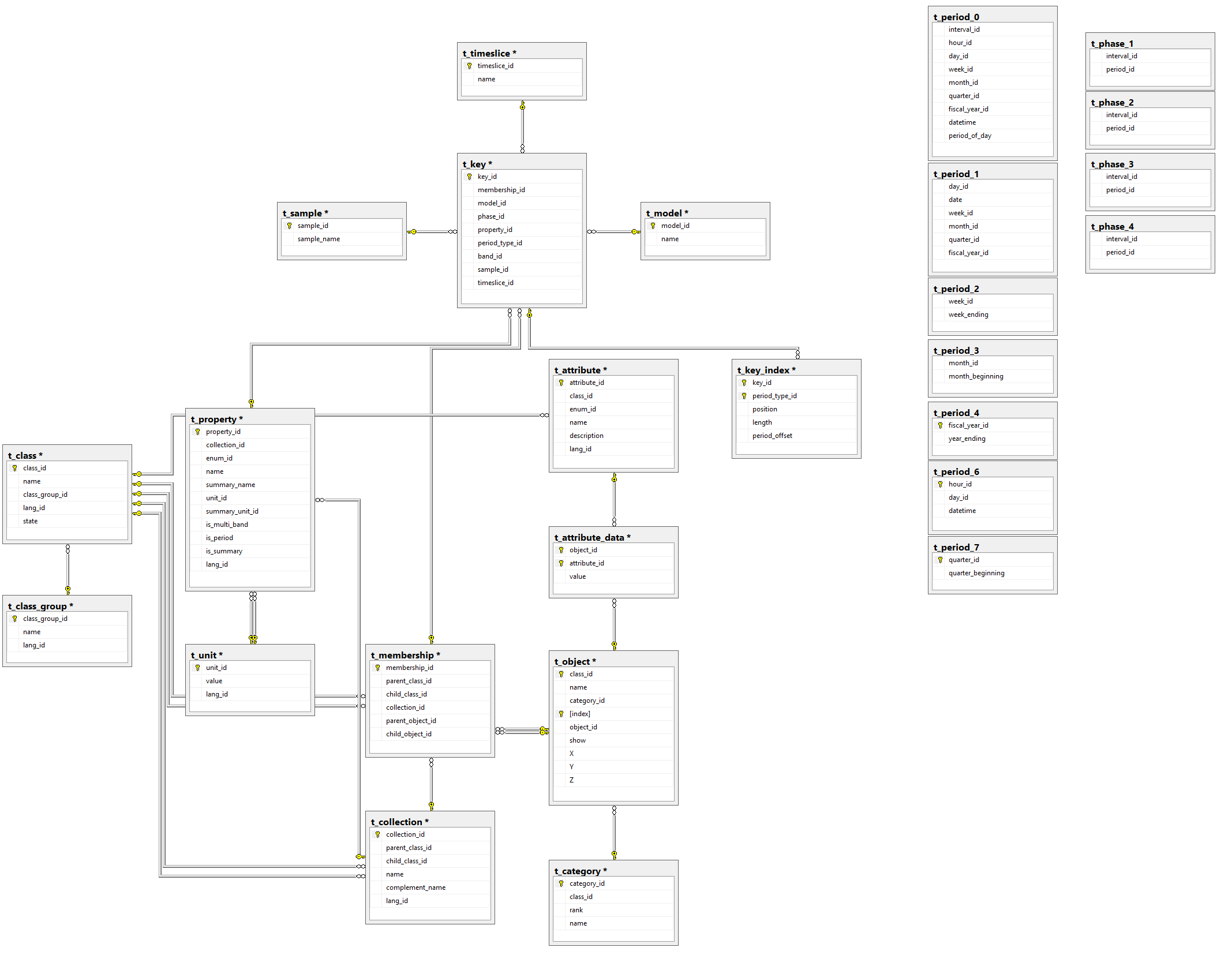Database Schema
Contents
1. Introduction
This article describes the input and solution database schema for PLEXOS. Both XML and Microsoft® Access .MDB file formats implement the same schema.
2. Input Database Schema
PLEXOS input databases describes two layers:
- Master Layer
- Data Layer
The Master Layer describes and defines rules for the input of data in the Data Layer. It builds the data model and rules in the following sequence
- Classes
- Collections
- Properties
Classes are types of objects e.g. Generator is a class, so is Fuel. Collections are unique combinations of classes (two only) e.g. the collection Generator.Fuels lists the fuels used by each generator.
- Objects (each assigned to a Class)
- Memberships (each assigned to a Collection)
- Data (each assigned to a Property)
In addition to these 'core' tables
The database schema defines primary keys and referential integrity rules that must be followed. These ensure that:
- Invalid combinations of objects cannot be created in memberships
- No duplicate definitions exist for objects or memberships
- Deleting objects results in cascaded deletions of memberships and properties
Thus the input database schema is completely self-contained and self-checking and it is impossible to orphan data.
Figure 1 illustrates the database schema for PLEXOS Version 5.x through 6.x.
This schema is very close to first-normal, meaning that there is no repetition of data, except as is required to enforce appropriate referential integrity rules. The structure is highly compact, making use of numeric keys wherever possible and storing string names of elements only once. In fact all keys and joins are made with integers.
Every user element (objects, memberships, data) are tagged with unique integer keys. These keys are self-generating (auto-numbers).
The tables in the schema are described in the following table:
| Table | Layer | Description |
|---|---|---|
| t_config | Master/Data | Miscellaneous configuration information for the database such as Revision number |
| t_class_group | Master | List of class groups e.g. "Production", "Transmission" groups |
| t_class | Master | List of classes e.g. "Generator", "Region", etc |
| t_category | Data | List of categories for each class of object e.g. "Generator" might have categories "Thermal" and "Hydro" |
| t_unit | Master | List of unit labels for properties e.g. "MW" for the property "Generation" |
| t_attribute | Master | List of attributes allowed on each class. Attributes are static values such as "Longitude" and "Latitude" for "Generator" objects |
| t_collection | Master | List of collections defining the types of memberships allowed e.g. "Generator" has a "Fuels" collection |
| t_property_group | Master | List of property groupings e.g. "Production", "Expansion" properties, etc |
| t_property | Master | List of properties allowed on each collection e.g. "Transport Charge" is a property on the "Generator.Fuels" membership type |
| t_collection_report | Master | List of collections that are inferred from user memberships e.g, a "Generator" belongs to one or more "Region" objects via its "Generator.Nodes" memberships and the "Node.Region" membership |
| t_property_report | Master | List of report properties e.g. "Generator" has report property ''Generation" |
| t_object | Data | List of user-defined objects by class |
| t_attribute_data | Data | List of attributes defined on the objects |
| t_membership | Data | List of memberships between objects e.g. "Generator" "Thermal" may use "Fuel" "Coal" through the "Generator.Fuels" collection |
| t_report | Data | List of report properties selected by the user |
 Figure 1: PLEXOS 7.x Input Database Schema
Figure 1: PLEXOS 7.x Input Database Schema
3. Solution Database Schema
The schema for the solution database files is shown in Figure 2 and described in the following table.
| table | Layer | Description |
|---|---|---|
| t_class_group | Master | List of class groups e.g. "production","Transmission" groups |
| t_class | Master | List of classes e.g. "Generator", "Region", etc |
| t_category | Data | List of categories for each class of object e.g. "Generator" might have categories "Thermal" and "Hydro" |
| t_unit | Master | List of unit labels for properties e.g. "MW" for the property "Generation" |
| t_attribute | Master | List of attributes allowed on each class. Attributes are static values such as "Longitude" and "Latitude for "Generator" objects |
| t_collection | Master | List of collections defining the types of memberships allowed e.g. "Generator" has a "Fuels" collection |
| t_property | Master | List of properties allowed on each collection e.g. "Transport Charge" is a property on the "Generator.Fuels" membership type |
| t_object | Data | List of user-defined objects by class |
| t_attribute_data | Data | List of attributes defined on the objects |
| t_membership | Data | List of memberships between objects e.g. "Generator" "Thermal" may use "Fuel" "Coal" through the "Generator.Fuels" collection |
| t_model | Master | List of "Model" objects that are included in the solution database. This applies only to solutions of "Project" objects |
| t_phase | Master | List of simulation phases e.g. "LT Plan", "ST Schedule" |
| t_band | Master | List of band numbers for multi-band data such as "Offer Quantity" |
| t_sample | Master | List of samples for multi-sample simulations |
| t_timeslice | Master | List of timeslices reported on |
| t_key | Master | List of keys each of which is a unique combination of model, phase, property, band, sample and timeslice |
| t_period_0 | Master | List of intervals e.g. 5-minute or 1-hour periods in the horizon |
| t_period_1 | Master | List of calendar days in the horizon |
| t_period_2 | Master | List of weeks in the horizon |
| t_period_3 | Master | List of calendar months in the horizon |
| t_period_4 | Master | List of fiscal years in the horizon |
| t_phase_1 | Master | Map of intervals to periods in LT Plan |
| t_phase_2 | Master | Map of intervals to periods in PASA |
| t_phase_3 | Master | Map of intervals to periods in ST Schedule |
| t_phase_4 | Master | Map of intervals to periods in ST Schedule |
| t_data_0 | Data | List of solution values by period |
| t_data_1 | Data | List of solution values by day |
| t_data_2 | Data | List of solution values by week |
| t_data_3 | Data | List of solution values by month |
| t_data_4 | Data | List of solution values by fiscal year |
 PLEXOS 7.x Solution Database Schema
PLEXOS 7.x Solution Database SchemaPlease see the following page for information about interacting with PLEXOS databases and Solution files using the dataset to SQL Utility.